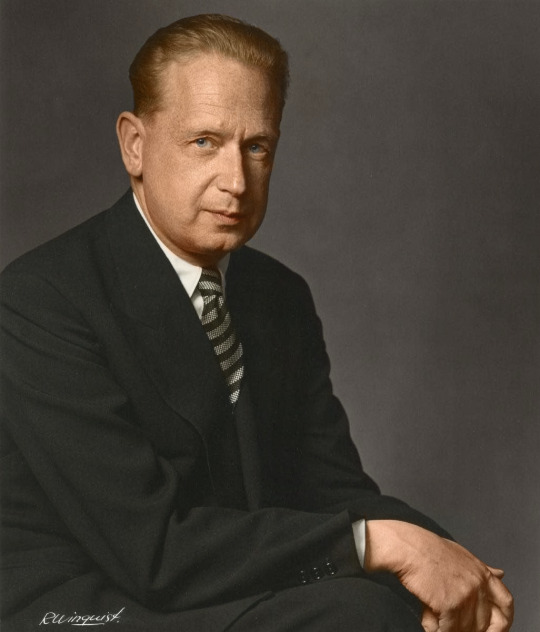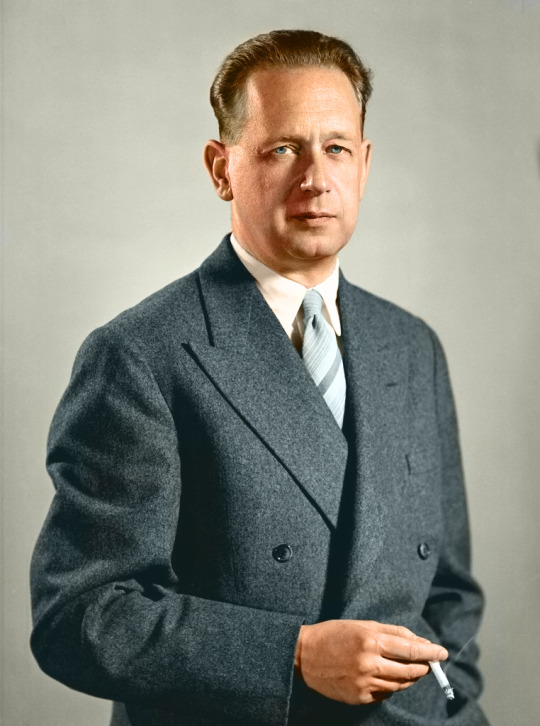This is a fan blog. Any opinions expressed are my own unless cited otherwise.
Don't wanna be here? Send us removal request.
Text

Dag Hammarskjold by Rolf Winquist
Colorised by me
(Source)
1 note
·
View note
Text
man with excellent self restraint dismayed to realize that not wanting anything is more likely a depression symptom than a carefully honed skill that atones for other aspects of his character
129K notes
·
View notes
Text
free will is an illusion until something bad happens. then it's all my fault.
5K notes
·
View notes
Text


#Trygve Lie#[Yeah yeah he is probably homophobic but still]#[Hilarious lastname also]#gay allegations
1K notes
·
View notes
Text
*makes a speech about anti-colonialism in the most King’s English British accent ever
0 notes
Text
Death, Sacrifice, and Suicide: Markings and Dag Hammarskjold (Part 1: 1925-1949)
(Warning: mentions of suicide. Please do not read if you are sensitive to the topic)
Introduction
These three themes are present Markings even before his mandate as Secretary-General, and permeate the work after. Biographies such as the one by Lipsey and the foreword of Markings written by Auden mention him being tempted by suicide and his passive suicidality by way of being reckless with his own safety.
[To briefly clarify “passive suicidality” as is referred and will be referred to, it is a sentiment that 1) considers the death of himself, 2) while not displaying active desire to see death out, expresses death as some sort of “fulfillment”, “release”, or natural result of his “duty”, and 3) expresses a resignation or even willingness to met his own death, whenever that may be.]
Death is a topic I want to discuss with regards to Dag Hammarskjöld and Markings, as death, sacrifice, and his suicidality are so intricately linked within Markings that one could not help but interpret his death as a tragic, but almost morbidly poetic end to his life and career. Thus, I want to create a compilation post that serves as a reference for all the individual instances where death is considered in Markings.
Within Markings, many entries explore either his own death, or someone else’s. Not all will meet the criteria for passive suicidality, but will be included to help illustrate his frame of mind when it comes to death.
Lastly, since Markings does have a strong literary element, it is possible that some entries may be interpreted differently by different people. The inclusion of entries in this post represents the interpretation of this author only.
(Warning: below contains graphic descriptions of suicide)
1925-1930 (Age: 19-25)
Smiling, sincere, incorruptible— His body disciplined and limber. A man who had become what he could, And was what he was— Ready at any moment to gather everything Into one simple sacrifice.
This passage has been speculated to have been added to Markings at a later date.
While not directly related to suicide, this is very typical of how sacrifice is described in later entries, with a sense of inevitability and an abstract modernist aesthetic, reminiscent of the art styles he has been known to like.
Tomorrow we shall meet, Death and I— And he shall thrust his sword Into one who is wide awake. But in the meantime how grievous the memory Of hours frittered away.
Life only demands from you the strength you possess. Only one feat is possible — not to have run away.
I think most mentions of Hammarskjöld’s attitude towards suicide do not mention this entry. To not run away from life — has he already been contemplating suicide this early on? Or does it simply refer to not running away from the demands of life, within life?
1941-1942 (Age: 35-37)
There is only one path out of the steamy dense jungle where the battle is fought over glory and power and advantage — one escape from the snares and obstacles you yourself have set up. And that is — to accept death.
This is not necessarily indicative of suicidality, but in my experience, simply talking about accepting death at a younger age in a (modern) western background has gotten me weird looks. I am personally far removed from the average person’s perception of death, but I imagine most people do not contemplate death as much.
1945-1949 (Age: 39-44)
Before it became clear to us what had happened, he was already too far out. We could do nothing. We only saw how the undertow was dragging him faster and faster away from the shore. Saw his futile and exhausting struggle to touch the bottom beneath his feet. (…)
(…) She walked to the end of the esplanade, and then waded out through the mud until the water was deep enough and the current swept her away. But she did not sink. The water pushed her back. Again and again, until her strength was exhausted, she opened her mouth and thrust her face under the surface. This time it must not fail. She heard cries from the bank. If they would… During their attempts at artificial respiration, they have laid bare the upper part of her body. As she lies stretched out on the riverbank — beyond all human nakedness in the inaccessible solitude of death — her white firm breasts are lifted to the sunlight — a heroic torso of marble-blonde stone in the soft grass.
When the gun went off, he fell on his side beneath the maple trees. (…) Why —? Above the spreading pool of blood no questions reach the land you have sought. And no words can any longer call you back. — That eternal “Beyond” — where you are separated from us by a death chosen long before the bullet hit the temple.
Descending into the valley, at the last curve he lost control of the car. As it toppled over the bank at the side of the road, his only thought was: “Well, at least my job’s done.” His one, weary, happy thought. It wasn’t so: he was to go on living. But not to go on with journey. When he came to, the solid world again took shape around him, he could hardly keep back his tears — tears of self-pity and disappointment because his vacation plans had been ruined. (…)
This section within Markings is unusual in that it strays from the usual poem or short paragraph of thought, instead it is a sequence of short-story-like scenes.
Between the descriptions of death and suicide (that he was presumed to have witnessed by his biographers), were descriptions of a dreary, daily life: a man losing interest in his work for he believed he was no longer free, a man aimlessly drifting in the streets, only seeing his own meanness on the faces of others, an epitaph being given to a woman, and a man who, while attending to his work, got into conflict with everyone around him.
They, while mildly out of order, likely correlate to the suicides depicted. The man who believed himself no longer free let himself be dragged out to sea; the man who could only see his own meanness as if in Dante’s hell put a bullet in his head; the epitaph was about the woman who drowned, and later her daughter; the man who survived the car crash became impossible to deal with.
Beyond the idea of death, where many had already previously interpreted the scenes of suicide to be exploring, perhaps the entries between the depictions of death were just as important as explorations of life. The first two contemplates what leads someone to suicide, and the latter two what happens afterwards.
Perhaps they were the thoughts that Hammarskjold had been contemplating: to believe oneself to not be free, to wander lethargically and not have taken a risk to “reach perfection”, to finally succeed and have someone else follow, or to fail and find living more difficult.
More to be discussed in part 2.
2 notes
·
View notes
Text
Here’s the worst one for now:
My father was fifty-six when he had to leave politics for good; I’m wondering what will happen to me.
On his 56th birthday in 1961, 2 months before his death
Source: Dag Hammarskjöld by Brian Urquhart
I need to make a thread of every time Hammarskjöld has inadvertently hinted to his own death. Past a point it stopped being foreshadowing and started to become writings on the wall
7 notes
·
View notes
Text

Don’t worry it’s just a joke no homo guys
Source: Hammarskjöld: A life by Roger Lipsey
#editor comment:#[found this while digging through biographies]#[the character of peter makes a lot more sense now in the movie]#gay allegations#dag hammarskjold
6 notes
·
View notes
Text
Not sure if I want to include passages from Markings, since a) interpretation of his poems can vary wildly, and b) death and sacrifice permeates his journal from start to finish, while I think it is related to what I interpret as a sort of passive suicidality, will make making the distinction between that and “him subconsciously knowing he is dying soon” very difficult.
I need to make a thread of every time Hammarskjöld has inadvertently hinted to his own death. Past a point it stopped being foreshadowing and started to become writings on the wall
7 notes
·
View notes
Text
I need to make a thread of every time Hammarskjöld has inadvertently hinted to his own death. Past a point it stopped being foreshadowing and started to become writings on the wall
7 notes
·
View notes
Text

Dag Hammarskjöld, first official portrait taken at the UN, April 11, 1953, Credit: UN photos (#57726)
Colorised by me
#dag hammarskjold#united nations#portrait#colorised#editor comment:#[this is the first time I colorised anything]
2 notes
·
View notes
Text


I cannot believe it, I found the Hammarskjold movie
I really enjoyed it, it is about everything I would ask for
Thoughts under the read more, will include spoilers
I really like the direction, the dichotomy between Hammarskjold the Secretary-General and Dag the person. I see why some wanted more focus on the crisis itself, but I actually think the crisis is not that relevant to him, as the subject of the movie. And given the almost 2 hour run time already, I think it was the right decision.
I cannot talk about the dichotomy between Secretary-General and man without talking about Peter. I remember reading that the director added Peter as a stand-in for him, as a voice to which he said what he wanted to Dag. I definitely see that, but his sub-plot with Dag was so good it is barely noticeable. (And I respect the rpf self insert shipping 😂)
In the movie, Dag and Peter knew each other since University, but were estranged after Peter tried to kiss him on a camping trip. It’s almost like a romcom setup - the love interest reappears into the protagonist’s life in a time of turmoil and uncertainty, reigniting feelings the protagonist long repressed. In the past, Peter even gave him a gift - a statue of a unicorn - something Dag would later use in Markings to describe himself.
The conflict within Dag is so palpable. When Dag was told Peter had previously been found guilty of homosexuality in Sweden, the first thing he asked was if anyone else knew. When he rejected Peter for the second time, Greenback his pet monkey and sole companion died almost simultaneously… the parallel writes itself doesn’t it?
The Congo crisis itself was probably the weaker part of the movie, and I am fine with it. It quietly builds up in the background, and ends almost just as unsatisfyingly quiet. Because there is no fight at the climax, this is not a 3-arc narrative where everything is resolved, not even like the more well-known crises in the Cold War where everything ended generally better than it started, the crisis continued on for years, if not till modern day. Hammarskjold died, and the movie ends with him. I would suggest watching a different movie if you want to focus on the events of the crisis.
It somewhat reminds me of reading about the crisis in real life: you know what it is from the start, there is no gallant fight, you watch them walk away less hurt than the good people, you watch them win using all the dirty tricks, you know it doesn’t matter that the pilot who shot his plane down had tears in his eyes, you know how it ends.
Most other characters are relatively one-note, and I think it fits. Dag was a lonely, perhaps very repressed man. I think on some level he was afraid of being known so intimately, the way Peter did, and thus he keeps most people (that he didn’t know prior to being at the UN) at arm’s length.
The use of quotes from Markings were also well-chosen and well-timed. I could almost recite them by heart, and they fit very well into the plot. The movie does a really good job making you want to see Dag happy - in a cottage near his friends, back home in Sweden, no stressful job, and perhaps love. When Peter sent him a letter telling Dag that he had a right to be happy too, and Dag replied that Peter would be welcome when his term ended, it hurts ever more knowing it was too late.
I previously said this movie was my Oppenheimer, but that isn’t entirely accurate now, I suppose. Oppenheimer was a deeply polarising individual - the father of the atomic bomb - the movie must balance between his point of view and addressing the reality/horrors of him and his creation.
But Hammarskjold does not have this baggage - he is still by a wide margin considered the best Secretary-General of the UN, remembered universally positively. For once, Hammarskjold didn’t have to be the image of an impossibly perfect Secretary-General, he can be Dag. And I think he has more than earned it.
If this movie is all that the world will ever learn about Dag Hammarskjold, I would be satisfied. I would rank this a 10/10, but I am very easily satisfied by movies.
(If I got anything wrong, it’s probably because the version I watched had a dub in a language I do not speak, and subtitles that were not in sync with the movie)
12 notes
·
View notes
Text

#I appreciate Markings as much as everyone but every time I intentionally read it is comorbid with a bad mental health period#I cannot imagine him writing it#dag hammarskjold#Markings#Considering incorporating more memes or tumblr posts on this blog
0 notes
Text

“A seemingly hopeful Secretary-General in front of the UN building”
Art by @viktor-regnsky (instagram)
4 notes
·
View notes
Text

I have not but I will add it to my colossal reading list.
Here is just the ones I am going through, for now
Every press release, speech, statement Dag Hammarskjöld has ever made in the UN archives
His 4 books of Public Papers of the Secretary-General of the United Nations (I am also halfway through scanning the first book) (the contents overlap with the UN archives and my purpose is to find any that is not in the UN archives)
Keeping the Peace
Who Killed Hammarskjöld?
View from the UN by U Thant (the copy I got is older than I am, lol)
Two memoirs on the Congo Crisis, and one general history book on the DRC
Interventions by Kofi Annan
The Assassination of Lumumba

10 notes
·
View notes
Text



I cannot believe it, they yassified his room.
I personally think it would have emphasised his loneliness a lot better if they kept it closer to the real life room.
(Top: screeenshot of Hammarskjöld - Fight for Peace official trailer)
(Bottom 2: photo of Dag Hammarskjöld’s New York Apartment, National Library of Sweden)
They also got the side of the bed he sleeps on wrong as well.
9 notes
·
View notes